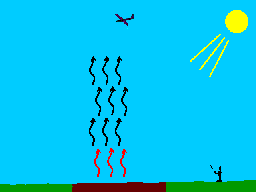R/C Sailplanes
What keeps sailplanes up if they don't have engines?
Rising air! Thermal-duration sailplanes take advantage of pockets of rising warm air (thermals) to gain altitude and extend their flight. It's not necessarily easy though. Finding and working a thermal takes a little science, a little art, a lot of experience, and more than a dash of luck.

In the above illustration, the sun heats an area of land unevenly. (Darker land masses, like parking lots and plowed fields absorb more heat energy.) The warm earth heats the air near it, causing it to be lighter than the surrounding air. As the warm air rises, it creates a "thermal". A skilled sailplane pilot will circle their plane in the rising air (lift) allowing the thermal to carry it aloft. The pilot can repeat this several times during a flight, seeking out more thermals. A flight typically lasts anywhere from 2 to 30 minutes, depending on conditions, but flights that last for hours are not impossible.
How do you get them up in the air
Generally, we use winches and high-starts. A winch is simply a line connected to an electric motor (like a car starter motor). The line is connected to a tow-hook on the sailplane, and a foot-pedal engages the winch motor to pull the plane aloft.
The photo on the left shows a "sport" winch, appropriate for light sailplanes. The image on the right shows how the winch pulls the line through a turn-around, towing the model sailplane up to altitude. When the sailplane is at the desired height, it flies off the tow-line and the pilot starts searching for thermals.


A high-start is a more economical approach that consists of a length of line attached to a length of surgical tubing. The tubing is stretched out and the line is attached to the plane. When released, the tubing contracts, pulling the sailplane up. A good launch can put a plane 200-400 feet in the air.
The photo on the left shows a typical high-start. The graphic on the right shows how, when the tubing contracts, the sailplane is pulled up. When the tubing is done contracting, the sailplane flies off the tow-ring and the pilot starts searching for thermals.


Slope-gliders and hand-launch gliders are generally tossed into the air by hand or lofted with a small high-start. The picture below shows one of our members performing a "discus" launch. That's where you hold your plane by the tip of the wing, spin around, and toss the plane into the air. Some remarkable launch heights can be obtained this way!

Slope-gliders are tossed by hand into the updrafts that are created when wind meets the side of a steep hill or cliff. Once there, the wind does the rest of the work for us. Click on the image below to see a short movie showing a hand-tossed launch at our slope soaring site.
What is "slope soaring"?
Slope soaring is flying a radio-controlled glider in lift that is created when wind hits a slope or near-vertical cliff. As the air hits the slope it is deflected up. Flying a model in slope lift is very similar to what hang-glider pilots do when they jump off cliffs and fly. With a stiff breeze and some experience, a slope-glider pilot can stay aloft for hours, all without benefit of an engine. Typically, slope-soaring requires a 15 MPH or stronger wind striking a fairly vertical land mass 100 feet or more in height. This is only a guideline, however, as pilots have been known to fly their planes wherever sufficient slope-lift is generated.
While thermal-soaring is usually peaceful and serene, slope-soaring is anything but. Slope soaring pilots surf the air currents performing loops, rolls, inverted passes, and just about every acrobatic trick in the book. Locations with reliable lift are often used for "slope-racing".

In the above illustration, wind approaches the slope and is deflected up. The rising air provides sufficient lift to keep the sailplane aloft for as long as the wind (and the plane's batteries) hold up.
What does it cost to get started?
Most people getting started in R/C gliders choose one of the many 2-meter designs. They are inexpensive and easy to build and fly. Startup costs would include the plane ($35-$50), building materials like glue and covering ($30-$40), and a radio system with receiver, battery, and servos ($180-$220). Of course, these are entry-level costs. The more high-tech you want to go, the more you are going to pay.
R/C Electric Airplanes
What kinds of airplanes can you fly with an electric motor?
All kinds! With recent revolutions in both battery and motor technology, the only limit is your imagination. We fly electric-powered sailplanes, scale reproductions, 3-D sport planes, and EDF (Electric Ducted Fan) jets. We even fly electric-powered helicopters!
What kind of batteries do you need to fly electric powered aircraft?
LiPos. (short for Lithium Polymer) The lightness and power density of these batteries has transformed the hobby! Usually, our battery packs contain two to three cells, giving us 7 to 11 volts powering the motors.
What kind of motors do these airplanes have?
“Brushless” motors are currently the most popular. There are two types: “inrunner” and “outrunner” – the difference being what part of the motor rotates. We also still use “brushed” motors, but they becoming less popular than the more powerful brushless options.
How long are the flights of electric-powered aircraft?
Motor run is typically anywhere from 5 to 20 minutes depending on the setup. The real determining factor, however, is the type of plane. An acrobatic plane that needs to have the motor on all the time will, likely, have shorter flights. If you fly a motor-glider, which uses the electric motor to pull the plane up to thermal-hunting altitude, the length of your flight is limited only by your ability to find thermals.
How do these planes compare to gas-powered planes?
If well built, they can compare very favorably in terms of performance. Since batteries add weight, the airframe is usually built as light as possible.
How much do electric-power planes cost?
The answer to that varies greatly with the size and sophistication of your airplane.You can get ready-to-fly (RTF) small “indoor” planes complete with a transmitter for a little over $100, but you don’t get much control over the airplane. A reasonably well-equipped “outdoor” electric airplane may cost $250-$400, not including the transmitter, but may be more if you go for a multi-engine airplane or an Electric Ducted Fan (EDF) jet.